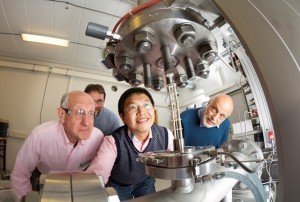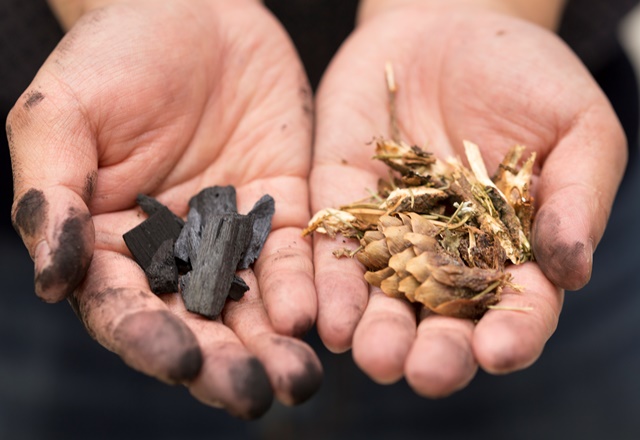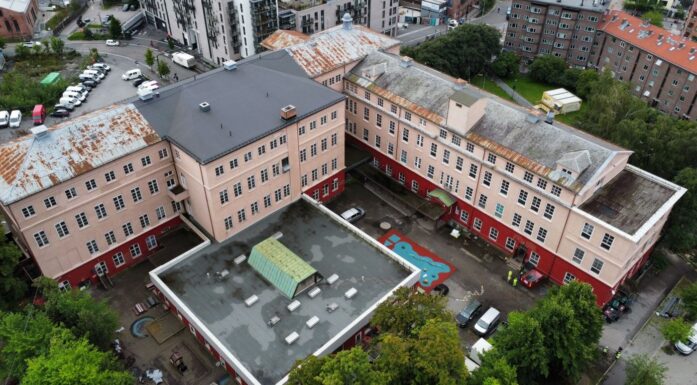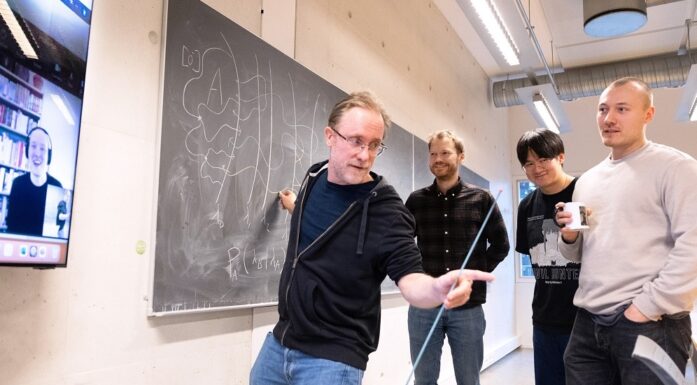Lopwood and brushwood make high-grade charcoal
When the forestry machines have finished extracting timber, what is left are tops and branches – waste which cannot be used. However, according to researchers, it is possible to turn these heaps of lopwood into high-quality charcoal.
Branches, tops, lopwood and brushwood that are left in felled areas after the timber has been extracted are now set to become more than just an irritation to hikers and berry-pickers. The aim is to turn these heaps of lopwood into the purest possible biocarbon. That’s charcoal, to you and me.
So the raw material, known in the trade as brash, is now being put under the microscope.
SINTEF Senior Researcher Øyvind Skreiberg isn’t holding back. “This could revolutionise Norwegian bio-energy production”, he says.
Four men, including professors from Hawaii and Hungary, and two SINTEF researchers, are gathered round a machine in a heat technology laboratory at Gløshaugen in Trondheim. This new acquisition is the only one of its kind in Norway, and is being used to analyse how biological material reacts to heat and pressure.
“We’re trying to find the optimum conditions for making charcoal from forestry waste. What kinds of pressures and temperatures deliver the best result and the best possible quality? This machine allows us to check the critical conditions needed to produce high-quality charcoal”, explains Skreiberg.
Reducing emissions
Skreiberg is heading the BioCarb+ research project, which will spend four years not only creating high-grade charcoal from cheap forestry waste, but also developing profitable ways of manufacturing the new product.
“The brash left behind after felling contains enormous quantities of energy. But it’s a low-value fuel, because it’s made up of so many different things. This is why it’s not used very much. If we can convert this cheap, easily available biomass into a high-quality, homogeneous fuel that is easy to handle, that would have major consequences in terms of the use of biofuel in Norway. It would also reduce emissions of greenhouse gases”, says Skreiberg.
In comparison with other fossil fuels, charcoal emits low levels of sulphur and nitrogen oxides. This would result in lower local air pollution.
SINTEF Energy, which is running the project, is getting assistance from several international partners. Among them are professors Michael Jerry Antal from Hawaii and Gabor Varhegyi from Hungary. Antal has developed a special pressurised reactor for the production of charcoal, in which biomass is heated under pressure.
From one to thousands of units of energy
This is all because charcoal can be used for much more than just grilling sausages on the barbecue. The manufacture of solar cells, for one thing. Several metallurgical companies have therefore joined the project as industrial partners. The process of converting silicon oxide (quartz) into pure silicon uses carbon as a reducing agent. Currently, the reducing agents used are fossil fuels such as coal and coke. However, if some of the fossil coal were to be replaced by charcoal, this would result in a considerable reduction in CO2 emissions from the manufacturing process. There would also be the environmental benefits of the solar cells themselves.

An internasjonal team:
From left: Michael J. Antal from Hawaii, Liang Wang from China and Gabor Varhegyi from Hungary. SINTEF-researcher Øyvind Skreiberg in the background.
Skreiberg illustrates these with the following maths exercise. One biomass unit of energy in, results in thousands of units of energy out – in the form of electricity produced by the solar cell during its lifetime.
“Elkem, one of our industrial partners, already uses a lot of charcoal. But this is imported from Indonesia. It is produced there using the old-fashioned method, with a low utilisation ratio of the energy in the timber used to make the charcoal. They are competitive only because of their low labour costs”, says Skreiberg.
“If we could manufacture charcoal here, with a much better energy yield and of a higher quality, then it could be financially worthwhile. Brash already has a market value, and it is lower than that of chips. Even stumps can be used. And we have plenty of resources. The forest grows again. Yet our domestic wood-processing industry is struggling. This innovation means that we may also be looking at making charcoal from broadleaved trees and trees of a quality that would normally be used to make paper.
Quality fuel
The other important area of application would be as a fuel, in the form of briquettes, pellets or finely crushed powder.
“We can obtain a homogeneous product that is easy to handle and has a high energy density, providing even and stable combustion. That would help to make the energy installations using this type of fuel more profitable. We in our living rooms could use this kind of fuel in appliances like wood-burning stoves. However, it could also be used in small district heating centres or combined heat and power stations. Charcoal powder could easily replace oil in these installations at times of peak load”, says Skreiberg. (Peak load is the portion of energy production from a bio-energy installation that cannot be covered by the plant’s primary source of fuel on the coldest days. Editor’s comment).
A new Norwegian industry?
As well as developing the technology, the project is also analysing all the financial aspects involved in a potential manufacturing chain. This is because the aim of the work is to come up with a process that someone might invest in, preferably in Norway.
BioCarb facts:
- BioCarb+ is a four-year project aiming to develop new strategies to produce charcoal from brash, tops and branches left over from tree felling, and establish a value chain for manufacturing.
- The project started in January this year, and will run until 2018. BioCarb+ is what is known as a Knowledge-building Project for Industry, with a total price tag of NOK 20 million. The Research Council of Norway is providing 80% of the funding, and industrial partners the remainder.
- The research partners in the project are SINTEF Energy, the Norwegian University of Science and Technology (NTNU), the Norwegian Forest and Landscape Institute, the Hawaii Natural Energy Institute and the University of Hawaii. The project is also working with researchers in Hungary, Italy and Finland.
- BioCarb+ has seven industrial partners: Norsk Biobrensel, AT Biovarme, Elkem, the Eyde-network, Saint Gobain Ceramic Materials, Eramet Norway and Alcoa Norway. These partners come from the forestry, fuel supplier and bio-energy sectors and the metallurgical industry. So all the links in the forest biomass value chain are represented.
Skreiberg hopes that an industrial company such as Elkem, which now uses imported charcoal, will get involved and finance a plant in Norway. That would increase sales of Norwegian forestry resources and would also increase the number of local jobs.
This kind of initiative is sorely needed, especially if we take into account the environmental targets adopted by the Norwegian parliament. Its white paper on climate said that there has to be a major focus on bio-energy, including a tripling of funds for research, combined with a target to double the use of bio-energy from 2008 levels by 2020. The research funding is in place, but we are still trailing behind the target of doubling the use of bio-energy.





